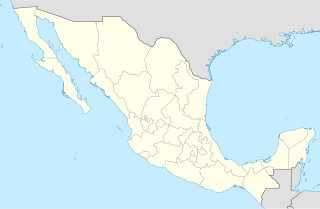| Federal Highway 49 | ||||
|---|---|---|---|---|
| Carretera Federal 49 | ||||
| Route information | ||||
| Maintained by Secretariat of Communications and Transportation | ||||
| Length | 689.68 km (428.55 mi) | |||
| North segment | ||||
| Length | 526.7 km [1] [2] (327.3 mi) | |||
| North end | ||||
| Major junctions |
| |||
| South end | ||||
| South segment | ||||
| Length | 162.98 km [4] (101.27 mi) | |||
| North end | ||||
| Major junctions | ||||
| South end | San Luis Potosí, San Luis Potosí | |||
| Highway system | ||||
Mexican Federal Highways
| ||||
Federal Highway 49 (La Carretera Federal 49) (Fed. 49) is a free (libre) part of the federal highways corridors () of Mexico. [6] The highway runs northwest-southeast in the western regions of the Mexican Plateau.

Mexico, officially the United Mexican States, is a country in the southern portion of North America. It is bordered to the north by the United States; to the south and west by the Pacific Ocean; to the southeast by Guatemala, Belize, and the Caribbean Sea; and to the east by the Gulf of Mexico. Covering almost 2,000,000 square kilometres (770,000 sq mi), the nation is the fifth largest country in the Americas by total area and the 13th largest independent state in the world. With an estimated population of over 120 million people, the country is the eleventh most populous state and the most populous Spanish-speaking state in the world, while being the second most populous nation in Latin America after Brazil. Mexico is a federation comprising 31 states and Mexico City, a special federal entity that is also the capital city and its most populous city. Other metropolises in the state include Guadalajara, Monterrey, Puebla, Toluca, Tijuana and León.

The Central Mexican Plateau, also known as the Mexican Altiplano, is a large arid-to-semiarid plateau that occupies much of northern and central Mexico. Averaging 1,825 m (5,988 ft) above sea level, it extends from the United States border in the north to the Trans-Mexican Volcanic Belt in the south, and is bounded by the Sierra Madre Occidental and Sierra Madre Oriental to the west and east, respectively.
Fed. 49 has two separate improved segments: The first segment runs from Ciudad Jiménez, Chihuahua to just northwest of Fresnillo, Zacatecas. The highway is co-signed with Fed. 40 for 104.6 km (65 mi) from Gómez Palacio to Cuencamé. [7]

Jiménez is a city and seat of the municipality of Jiménez, in the northern Mexican state of Chihuahua. As of 2010, the city had a population of 34,281, up from 33,567 as of 2005.

Chihuahua, officially the Free and Sovereign State of Chihuahua, is one of the 31 states of Mexico. It is located in Northwestern Mexico and is bordered by the states of Sonora to the west, Sinaloa to the southwest, Durango to the south, and Coahuila to the east. To the north and northeast, it has a long border with the U.S. adjacent to the U.S. states of New Mexico and Texas. Its capital city is Chihuahua City.

Fresnillo /fres'nijo/, founded in 1554 by Francisco de Ibarra, is the second largest city in Zacatecas state, north central Mexico and the seat of Fresnillo municipality. As a rail and highway junction, Fresnillo is the center of a rich mining area known especially for silver, and the location of one of the world's richest silver mines, the Mina Proaño or Fresnillo Mine, which belongs to the Peñoles mining company. It has a mining school, and agriculture and cattle raising are other important economic activities. Fresnillo is also the municipal seat of the municipality of the same name which surrounds it. The municipality had a population of 196,538 and an areal extent of 4,947 square kilometres (1,910 sq mi).
The second segment runs from Las Arcinas, Zacatecas to San Luis Potosí, San Luis Potosí.

Zacatecas, officially the Free and Sovereign State of Zacatecas, is one of the 31 states which, with the Federal District, comprise the 32 Federal Entities of Mexico. It is divided into 58 municipalities and its capital city is Zacatecas City.

San Luis Potosí, commonly called SLP or simply San Luis, is the capital and the most populous city of the Mexican state of San Luis Potosí. The city lies at an elevation of 1,864 metres. It has an estimated population of 824,229 in the city proper and a population of approximately 1,221,526 in its metropolitan area, formed with the neighbour city of Soledad de Graciano Sánchez and other surrounding municipalities, which makes the metropolitan area of Greater San Luis Potosí the eleventh largest in Mexico.
